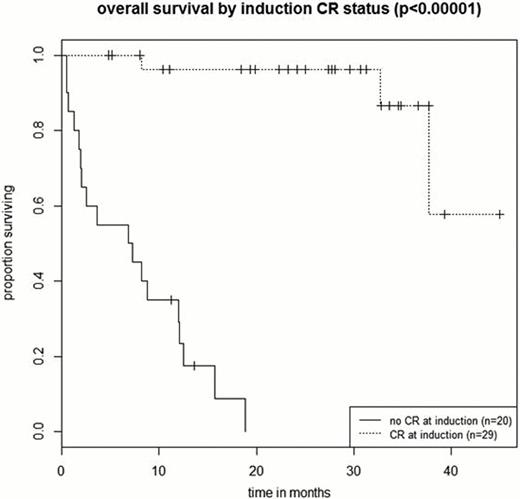Abstract
Abstract 2693
Aggressive B-cell NHL harboring a c-MYC rearrangement (myc+) with or without t(14;18) is associated with shortened PFS and overall survival (OS) (Savage, Blood 2009; Johnson, Blood 2009). Clinical presentation, risk-assessment, and therapies vary among pts and institutions. We reviewed pts with myc+ and double hit NHL treated at the Ohio State University (OSU) from Aug 2008-Jan 2012 to determine factors associated with prolonged PFS and OS.
Pts with de-novo B-cell NHL who were myc+ by FISH break-apart probe were included. Pts with Burkitt's, follicular, and transformed NHL were excluded. Most pts were also evaluated for presence of t(14;18) by FISH, and those myc+ pts with t(14;18) were classified as double hit NHL. Response was determined by PET/CT at the completion of first-line therapy. Associations between myc+ and clinical characteristics were described. PFS and OS were defined from date of diagnosis to date of relapse or death. Univariable and multivariable Cox regression models were performed to assess relationships of selected clinical variables with PFS and OS.
Of 49 myc+ pts, 55% were male, and median age at diagnosis was 62 (range: 23–83). Morphologically, 30 pts had diffuse large B-cell lymphoma (DLBCL), 10 pts had B cell lymphoma unclassifiable with features intermediate between diffuse large B cell and Burkitt lymphoma (BCLU), and 9 pts had high grade NHL not otherwise specified. Twenty-eight pts had ECOG performance status ≤1, and 40 pts had stage III-IV disease. Twelve pts had bone marrow involvement, and 26 pts had bulky disease ≥5cm. IPI was ≥3 in 24 pts, and median Ki-67 was 90% (range: 45–100). Twenty-nine of 43 assessed pts (67%) were positive for t(14;18). Therapies included R-CHOP (N=17), R-EPOCH (N=17), Burkitt's-like (ie, R-HyperCVAD, R-CODOXM/IVAC, or R-CHOP with high dose methotrexate; N=11), or other (N=4). No pts underwent autologous transplant in first remission. Twenty-nine pts (59%) achieved a complete response (CR), 2 pts had a partial response, 1 pt had stable disease, 8 pts had progressive disease (PD), and 9 pts died before response assessment (5 pts after cycle 1, 3 pts after cycle 2, and 1 pt after cycle 3). With a median follow-up of 26.2 months (mos; range: 4.8–45.0), the median PFS for all pts was 16.6 mos (95%CI: 9.6 - not reached=NR), and median OS was 37.7 mos (95%CI: 15.7–NR). Median PFS was 3.9 mos for pts without CR vs. not yet reached in pts with CR (p<0.00001). Median OS was 7.0 mos for pts without CR vs. not yet reached for those with CR (Figure 1A; p<0.00001). CR pts were treated with R-CHOP (N=12), R-EPOCH (N=9), Burkitt's-like (N=6), or other (N=2). Four of the CR pts have relapsed at 6, 9, 11, and 17 mos, and 25 CR pts remain in remission at a median follow-up of 27.5 mos (range: 4.8 – 45). Of 3 pts with PR or SD, 2 pts progressed at 3 and 11 mos, and 1 PR pt was lost to follow-up at 15 mos. Of 21 pts who have died, 3 had CR. Median PFS and OS were 8.0 and 12.5 mos, respectively, in double-hit pts (myc+ with t(14;18)) vs. median PFS and OS not yet reached in pts who were myc+ without t(14;18) (p=0.04 for PFS; p=0.05 for OS). Additional factors associated with shortened PFS in univariable analysis included IPI ≥3 (p=0.0001), age ≥ 60 (p=0.046), and presence of B-symptoms (p=0.025). Morphology (DLBCL vs. BCLU), therapy received, Ki-67, and presence of bulky disease ≥5cm were not significantly associated with PFS or OS. In multivariable analysis, CR was independently associated with increased PFS (p=0.0036) and OS (p=0.008; Figure 1B), while t(14;18), morphology, front-line therapy, IPI, bulky disease, age, or presence of B- symptoms were not independently associated with PFS or OS. While increased IPI (p=0.00034) and B-symptoms (p=0.04) were associated with a failure to achieve CR, morphology and therapy were not.
While myc+ NHL, with or without t(14;18), has historically been associated with inferior PFS and OS, achievement of a CR with front-line therapy was indicative of a favorable PFS and OS vs. those who do not achieve CR. Additional evaluation of myc+ aggressive NHL is needed to characterize pre-treatment factors associated with achievement of CR and to further evaluate the association of CR to induction therapy with survival outcomes.
Overall Survival for pts with myc+ NHL achieving CR or not achieving CR.
Overall survival for pts with myc+ NHL with and without t(14;18) who do or do not achieve a CR.
Overall survival for pts with myc+ NHL with and without t(14;18) who do or do not achieve a CR.
No relevant conflicts of interest to declare.
Author notes
Asterisk with author names denotes non-ASH members.



